► Lamborghini vs Ferrari
► Front-engined vs mid-engined
► Aventador SVJ vs 812 Superfast
This is it. This is the most exciting drive possible. Nothing can match this, or so I decide after an insane 20-minute stint in the Lamborghini Aventador SVJ. And then something does match it: the Ferrari 812 Superfast. Although in many ways very different, the Ferrari is every bit as demanding and rewarding as the Lamborghini. Both leave me sweating and exhilarated, excited and energised, but also saddened. Because cars like this won’t be around for much longer.
It’s never been common, and of late the 12-cylinder engine has been a rarity in any shape or form. Scarcest of them all is the naturally aspirated kind, designed to tick all the performance-related boxes and stir emotions to their roots. While a supercharged or twin-turbo V8 can come close in terms of output and torque, the free-breathing 12 circles its own planet as far as throttle response, mid-range pick-up and a fearless redline are concerned. It partly trades refinement for raucousness, linearity for eruption, manners for raw performance.
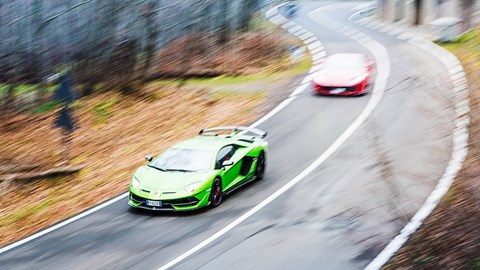
The flipside of that rawness is that any naturally aspirated 12-cylinder road car will struggle to meet emissions regulations and will fall well short of the fuel economy that smaller-capacity turbocharged and hybrid engines can offer. As a breed the unforced-induction V12 may be doomed, but it’s not going quietly. We went to Emilia-Romagna, home turf for both Ferrari and Lamborghini, to drive the two key survivors, the 812 Superfast and the Aventador SVJ, tackling climbs, descents and corners aplenty to see what it is they can do that nothing else can match.
The two fighters
The mid-engined, all-wheel-drive Lamborghini is the limited-edition SVJ version of the Aventador, with various changes including new cylinder heads and a lighter flywheel. The front-engined, rear-wheel-drive Ferrari is the 812 Superfast, the improved-all-round replacement for the F12.
Numerically, they’re close together. The 65º block of the Ferrari displaces 6496cc, while the Lamborghini’s 60º V12 is just 2cc larger. Both offer peak power at 8500rpm: 789bhp in the case of the 812, 759 for the Aventador SVJ; credit should go to the Ferrari’s freer flowing intake and exhaust systems. They’re closer on torque: 530lb ft vs 531. Dry weight is an identical 1525kg.
Their on-paper performance is fag-paper close too: the 812 Superfast will do 0-62mph in 2.9 seconds, hits double that speed in 7.9sec, and then peaks at 211mph, while the Aventador SVJ takes just 2.8 seconds to 62 and 8.6 to 125mph, and has a top speed of 219mph. The numbers may be close, and both cars may be loud, thirsty, dramatic and utterly thrilling at speed, but the duo are quite different in character. What sets the two beasts apart more than anything else is the vastly different packaging.
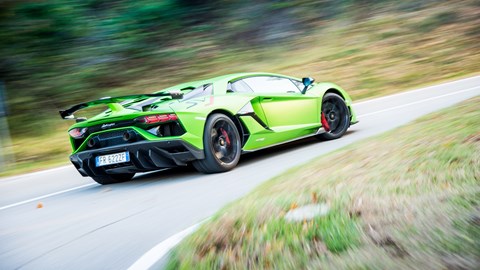
Inside the cockpits
All but the slenderest of drivers will find the SVJ tricky to get into and out of, and once inside they’ll find unwelcoming sports seats, a narrow pedal box, poor headroom and atrocious visibility. Overhead traffic lights are invariably out of sight, the huge rear-three-quarter blindspot is a potentially very expensive game of chance, stalks and knees are forever colliding, and the mix of Audi and Lamborghini details still doesn’t look right seven years after the Aventador’s launch.
In contrast to the Lambo, the Ferrari is almost a luxury suite. The seats come in three sizes, legroom is a relief, visibility could hardly be better, and it takes no time to master the manettino drive-mode selector, which lets you tweak the car’s manners with aplomb.
That said, the Ferrari’s front end is long enough to drop out of sight in dense fog, the secondary controls are fiddly and the turning circle is massive. Let’s keep it all in perspective: these are not comfortable, spacious cars if you’re driving all day, and they’re not luggage-friendly. Driven in full attack mode, they’ll both hammer your teeth, tattoo your palms and crack some spinal discs.
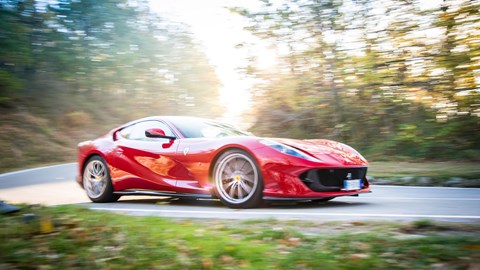
Firing them up emphasises their differences. In the SVJ, your index finger lifts the red cage door that protects the hell-breaks-loose button. In the 812, the red start-stop activator sits just a thumb stretch away on the busy steering wheel. The Ferrari engine responds with vigour to the starter button, boosts idle speed for a few seconds then settles down. The Lamborghini V12 initially sounds like it’s struggling to remember its firing order before it’s prepared for screaming and shivering action. Still searching for the right rhythm, the idle speed eventually manifests itself, noisily clearing its many throats.
The throttle response of the Lambo feels like it can trigger thunder and lightning simultaneously. So you’d better think twice before deactivating the stability control, because all it takes to get you out of line is a puddle or two, some soggy leaves or an unforeseen imperfection in the road. All-wheel drive is a help, but the torque split clearly favours the rear wheels. On slow and winding turf, critical handling attitudes include snap oversteer and snap understeer. It’s feisty.
On the road
High above Pistoia, in the heart of wild boar country, the two cars display remarkably different road manners. In extremis, the Ferrari is quick to switch from nose-heavy to tail-happy. On the same roads at the same speeds, the Lamborghini is equally hard work but feels a touch faster to turn, thanks to the all-wheel-drive system. While its driven front wheels help to momentarily pull the car out of trouble and straighten up a ragged line, the system adds weight, numbs the steering when entering slow corners too fast, and hampers manoeuvrability.
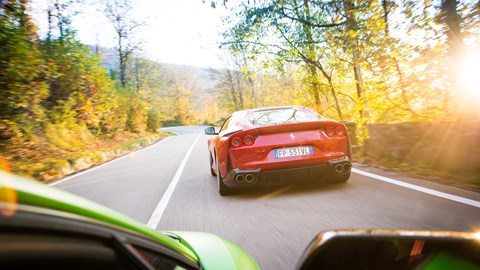
The 812 Superfast is emphatically rear-wheel drive, even on a straight road, in the dry, with the throttle not fully depressed. While the transaxle layout results in a perfectly balanced weight distribution, there is at all times enough grunt on tap to alert the e-diff and summon stability control. With the electronic aids off, the Ferrari is prone to spinning in tricky conditions.
The 812 encourages its driver to push deeper and deeper into tight bends, to corner with awesome lateral acceleration, to stimulate the driving wheels with generous boosts of torque, and to use steering and throttle to massage the delicate cornering balance. In second gear, the Ferrari willingly lights impromptu bonfires close to the apex. In fourth, short straights are inhaled as a whole without pausing for breath. In Race, full-throttle upshifts almost hurt. The brakes are simply sensational in terms of modularity, performance and repeatability.
On the autostrada, the Aventador is a road shark par excellence. Its brakes respond with the finality of a light switch. The heavy yet super-direct steering works with micrometric precision. At speed the dampers assume the lowest position and tautest calibration. The ALA active-aero system can either increase the downforce or reduce the drag resistance above 125mph, and the split ground-effect system directs airflow to the wheels that need it most, via a set of invisible motorised flaps.
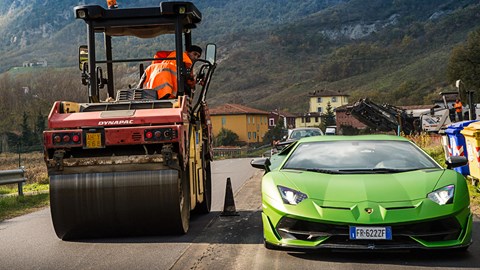
While the Ferrari softens its dampers at a finger’s split-second command, the most extreme Aventador bottoms out even in Strada mode until the chassis-control warning light comes on. The SVJ feels more at home on the racetrack than the Ferrari, while the 812 is much better than the Lambo on narrow and/or badly surfaced minor roads. Both are at their best on fast roads, where they zig-zag through traffic like invincible alien objects guided from a distant star.
What about the all-wheel steering fitted as standard on both supercars? It’s impossible to detect the transition from synchro-steer to counter-steer, so there’s certainly no harmful effect on either car’s dynamics.
How anti-social are they really? They’re certainly both thirsty, the Lamborghini in particular. And they’re not only noisy, but both have extra popping and banging engineered-in. In some circumstances the noise is a virtue, part of a piece with the looks. People love the whole spectacle. Sorry, some people love the whole spectacle. In our three days in these cars on these roads, we saw jaws drop, barking dogs leaping excitedly into the air and traffic cops egging us on, ZZ Top-style.
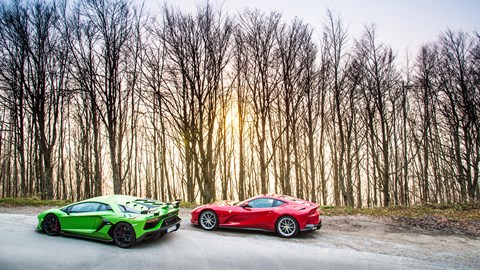
The teenage crazies on their scooters would do anything to snatch a picture, rejoicing with thumbs up and high-fives. In working-class Italy – where hoarse diesels and breathless three-cylinder minis rule the roads – the two loud supercars are received with enthusiasm and national pride, not envy and admonitory finger-swagging.
On the open road, however, we feel less like heroes; too many other drivers would really rather not move over to let us have our fun. It’s safer to escape to the country, where traffic tends to be light and corners outnumber straights 99 to one.
V12 twin test: verdict
Choosing between these two V12s is as subjective as favouring red wine over white. The Lambo engine marks the ultimate evolution of a legend which is almost as old as the brand. The Ferrari is powered by a more advanced and more economical engine, but as soon as revs soar it is every bit as explosive. Logic says these cars are way too fast for normal traffic, too radical for normal roads, too challenging for normal owners, too vulnerable to qualify as daily drivers. But Lord knows we’ll miss them when they’re gone.